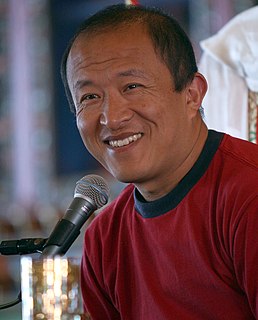
Dzongsar Jamyang Khyentse Rinpoche, also known as Khyentse Norbu, is a Tibetan/Bhutanese lama, filmmaker, and writer. His four major films are The Cup (1999), Travellers and Magicians (2003), Vara: A Blessing (2013), and Hema Hema: Sing Me a Song While I Wait (2017). He is the author of What Makes You Not a Buddhist (2007) and many other non-fiction works about Tibetan Buddhism.
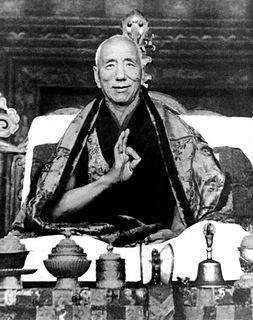
Dzongsar Khyentse Chökyi Lodrö was a Tibetan lama, a master of many lineages, and a teacher of many of the major figures in 20th-century Tibetan Buddhism. Though he died in 1959 in Sikkim, and is not so well known in the West; he was a major proponent of the Rimé movement within Tibetan Buddhism, and had a profound influence on many of the Tibetan lamas teaching today.

Sera Monastery is one of the "great three" Gelug university monasteries of Tibet, located 1.25 miles (2.01 km) north of Lhasa and about 5 km (3.1 mi) north of the Jokhang. The other two are Ganden Monastery and Drepung Monastery. The origin of its name is attributed to a fact that during construction, the hill behind the monastery was covered with blooming wild roses.

Drepung Monastery, located at the foot of Mount Gephel, is one of the "great three" Gelug university gompas (monasteries) of Tibet. The other two are Ganden Monastery and Sera Monastery.
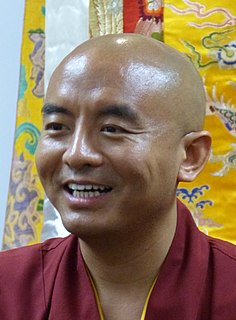
Yongey Mingyur Rinpoche is a Tibetan teacher and master of the Karma Kagyu and Nyingma lineages of Tibetan Buddhism. He has authored two best-selling books and oversees the Tergar Meditation Community, an international network of Buddhist meditation centers.

Mindrolling Monastery, is one of the "Six Mother Monasteries" of the Nyingma school in Tibet. It was founded by Rigzin Terdak Lingpa in 1676. Tendrak Lingpa's lineage is known as the Nyo lineage. The name in Tibetan means "Place of Perfect Emancipation". It is located in Zhanang County, Shannan Prefecture, Tibet Autonomous Region, China, known as U-Tsang. Mindrolling Monastery is approximately 43 kilometers east of the Lhasa airport, on the south side of the Tsangpo river.

The Palcho Monastery or Pelkor Chode Monastery or Shekar Gyantse is the main monastery in the Nyangchu river valley in Gyantse, Gyantse County, Shigatse Prefecture, Tibet Autonomous Region. The monastery precinct is a complex of structures which, apart from the Tsuklakhang Monastery, also includes its Kumbum, believed to be the largest such structure in Tibet, that is most notable for its 108 chapels in its several floors and the old Dzong or fort.
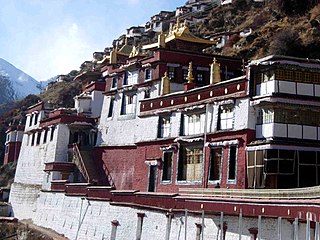
Drigung Thil Monastery is a monastery in Maizhokunggar County, Lhasa, Tibet founded in 1179. Traditionally it has been the main seat of the Drikung Kagyu tradition of Tibetan Buddhism. In its early years the monastery played an important role in both religion and politics, but it was destroyed in 1290 by Mongol troops under the direction of a rival sect. The monastery was rebuilt and regained some of its former strength, but was primarily a center of meditative studies. The monastery was destroyed after 1959, but has since been partly rebuilt. As of 2015 there were about 250 resident monks.
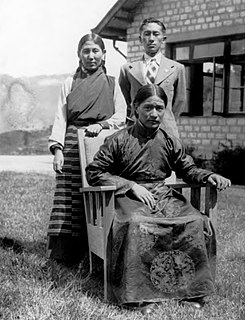
Kyabje Dudjom Jigdral Yeshe Dorje known as Terchen Drodül Lingpa and as Dudjom Rinpoche, is considered by Tibetan Buddhists to be from an important Tulku lineage, a renowned Tertön treasure revealer and a direct incarnation of Padmasambhava and of Dudjom Lingpa (1835–1904). He is a Nyingma householder, yogi, and a Vajrayana and Dzogchen master, and according to disciple Khenpo Tsewang Dongyal is referred to by them as "His Holiness" and as a "master of masters".
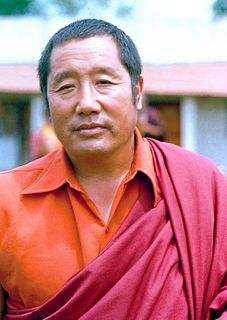
Kyabjé Drubwang Padma Norbu Rinpoche, 1932 – 27 March 2009, was the 11th throneholder of the Palyul Lineage of the Nyingma school of Tibetan Buddhism, and said to be an incarnation of Vimalamitra. He was widely renowned in the Tibetan Buddhist world as a master of Dzogchen. He was one of a very few teachers left from his generation who received all his training in Tibet under the guidance of what Tibetan Buddhists consider to be fully enlightened teachers.

Bylakuppe is an area in Karnataka which is home to the Indian town Bylakuppe and several Tibetan settlements, established by Lugsum Samdupling and Dickyi Larsoe. Bylakuppe is the second largest Tibetan settlement in the world outside Tibet after Dharamshala. It is located to the west of Mysore district in the Indian state of Karnataka which is roughly 80 km from Mysore city.
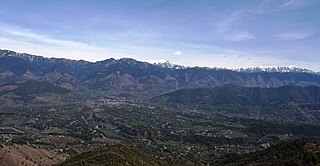
Jogindernagar, or Jogindar Nagar, is a municipality in Mandi district in the Indian state of Himachal Pradesh. Named after Raja Joginder Sen, the hill station is the terminus of the 163-kilometre-long (101 mi) Kangra Valley narrow-gauge railway. Jogindernagar is the third-largest city in the district. The only city in Asia with three hydro-electric power stations, its nickname is "The City of Powerhouses".

Lamaling Monastery, also known as Zangdrok Pelri Monastery and Burqug Lamaling (布久喇嘛林寺), is a Buddhist monastery located near the village of Jianqie, Burqug Township, Bayi District, in Tibet, on a small hill 1.5 km south of Buchu Monastery. The monastery belongs to the Nyingmapa sect, translated as the ‘Ancient Ones’; their lineages go back to the first infusion of Buddhism from India to Tibet in the 7th century CE. The Nyingma sect incorporated many of the traditions of the native Tibetan Bon religion, which respects nature and local nature spirits.

Baijnath is a town in Kangra district of Himachal Pradesh. It is about 50 kilometres from Dharamshala which is the district headquarters. The ancient temple of Lord Shiva (Baijnath) is situated here giving the town its name.

Bir Tibetan Colony is a Tibetan refugee settlement in the Himalayan village of Chowgan adjacent to the town of Bir, in the north Indian state of Himachal Pradesh.

Bir is a rural village located in the west of Joginder Nagar Valley in the state of Himachal Pradesh in northern India. It is also the location of the Bir Tibetan Colony, founded in the early 1960's as a settlement for Tibetan refugees after the 1959 Tibetan uprising.

Takthok Monastery is a Buddhist monastery in Sakti village in Ladakh, northern India, located approximately 46 kilometres east of Leh. It is the only monastery in Ladakh belonging to the Nying-ma-pa or Red Hat sect. The name Takthok, literally meaning 'rock-roof' was named because both its roof as well as walls are made up of rock. It belongs to the Nyingma tradition of Tibetan Buddhism and approximately 55 lamas reside there. It is the only Nyingma monastery in Ladakh.

Dzongsar Monastery is a Buddhist monastery in Dêgê County in the Garzê Tibetan Autonomous Prefecture of Sichuan, China, southeast of the town of Derge and east of Palpung Monastery. Historically it lay in the Kham region of Tibet. It was founded in 746, destroyed in 1958, and rebuilt in 1983.

Buddhism in the Indian state of Himachal Pradesh has been a long recorded practice. The spread of Buddhism in the region has occurred intermediately throughout its history. Starting in the 3rd century BCE, Buddhism was propagated by the Maurya Empire under the reign of Ashoka. The region would remain an important center for Buddhism under the Kushan Empire and its vassals. Over the centuries the following of Buddhism has greatly fluctuated. Yet by experiencing revivals and migrations, Buddhism continued to be rooted in the region, particularly in the Lahaul, Spiti and Kinnaur valleys.

Joginder Nagar Valley is a valley in the Indian state of Himachal Pradesh. The valley contains the town of Joginder Nagar, Bir-Billing, Chauntra and various other hill resorts surrounded by mountains on all sides. The valley falls in the mid-hill zone of the Dhauladhar mountain range in the foothills of the Indian Himalayas. Geographically, the valley starts near Ghatta at its westernmost point and stretches south-eastwards up to Ghatasani, 15 kilometres from the main town. On an average, the valley is stretched 20 kilometres in length and 10 kilometers in width.


















